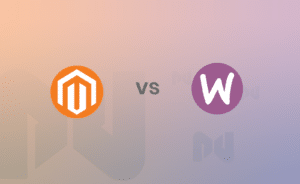Magento vs WooCommerce: How Opposites Attract

Two applications you’ll be introduced to early on are Magento and WooCommerce. Both are used by an impressive number of stores. WooCommerce has over 3 million stores using it as a platform, while Magento has over 200,000. Both also offer great feature sets that can be expanded easily with extensions, and both have incredibly supportive communities.
So why would you choose one over the other?
This article takes a look at exactly that, by pitting Magento and WooCommerce against each other. If you’re a merchant that still needs to make this choice, then keep reading to find out more.
Summary
Magento Pros and Cons
Magento is a powerful ecommerce platform capable of empowering merchants to create storefronts unlike any other. Originally released March 2008, it has since grown and inspired the release of a new version, Magento 2, in 2015. This version has gone on to become the perfect ecommerce platform for storefronts with a global reach.
Pros
- A powerful ecommerce platform capable of creating unique user experiences
- Offers more customization options that WooCommerce
- An incredible community that, despite being smaller than WooCommerce’s, manages to easily hold its own
- True hosting optimization through an optimized Magento hosting provider
Cons
- Requires a developer to create a fully functioning storefront
- Costs more than a WooCommerce implementation
WooCommerce Pros and Cons
As a plugin for WordPress, WooCommerce comes armed with features that make it great for managing both content and ecommerce. Originally launched in 2011, it has grown to become the most used and versatile ecommerce platform around, with over 3 million active installs worldwide.
Pros
- Easy to use and get started with
- A huge range of templates and themes for merchants without any coding knowledge
- Allows for better integration of the ecommerce and content sections of a site
Cons
- Doesn’t afford the same level of customization as Magento
- Doesn’t allow for the creation of unique buyer experiences to the same degree as Magento
- Lacks some of the truly powerful integrations available
Performance
Questions about speed and power are usually some of the first questions merchants ask. Most of the time, merchants need to prioritize one. That especially holds true when comparing Magento and WooCommerce.
While Magento may offer more in terms of power, it also requires more resources to deliver the same experience as WooCommerce. WooCommerce, on the other hand, is a very lightweight and fast platform, but it lacks a lot of the functionality you’ll find with Magento.
WooCommerce Is Lightweight
We’ll say it again: WooCommerce is lightweight. This means the same hardware and resources can serve more customers with a WooCommerce store than with a Magento one. Take a look at our SIP and SIPWOO plans to see what this means in terms of real numbers.
| Magento | WooCommerce | |
| Daily Visitors | 5,000 | 10,000 |
*Based on a SIP 400 server build.
Despite meaning more customers, the lightweight WooCommerce platform has comparatively limited functionality. When creating a Magento store, merchants are empowered to create integrated, omnichannel journeys, where their online storefront is just a part of the buyer’s experience. With WooCommerce, this just isn’t the case.
WooCommerce lacks an out of the box ability to track activity through other channels and deliver a personalized experience. This feature can be added by installing several plugins. However, any store overloaded with plugins is then going to suffer in terms of performance.
Magento Requires the Right Host
For Magento, it’s important to host with a provider that offers optimized infrastructure. While several providers state that they offer optimized hosting, the reality is that only a handful truly optimize their infrastructure for Magento. Hostdedi is known to offer a truly optimized hosting foundation. Here are four reasons why.
In addition to finding the right hosting provider, the quality of the code used to create a Magento store can also have a significant impact. Poorly edited code and unoptimized extensions can easily cause any server-side optimizations to lose their significance. If you’ve tried everything else and your store is still crawling, it may be a good idea to start a code audit.
Poorly edited Magento code and unoptimized extensions can easily cause any server-side optimizations to lose their significance.
Two Different Performance Bands
Like much of this comparison, Magento and WooCommerce fall into two different performance bands. WooCommerce is a lightweight contender, with comparatively less power behind it, but it is quick and nimble. Magento has much more power behind it, but it needs a lot of support from behind the scenes.
We’re calling this a draw, with the better application’s performance-based specific use cases and what they need: power or speed.
Functionality
Magento has long been known as the ecommerce king of functionality. Not only does it allow for the creation of unique and personalized user journeys, but its integration capabilities are second to none.
With that said, a savvy developer can still get a lot out of WooCommerce. Both applications come with REST API, allowing developers better management of products and orders. This also provides flexibility for developers to build an API that meets the needs of diverse merchants.
The WooCommerce REST API documentation (including hooks, endpoints, filters, and more) can be found here. Similar documentation for Magento can be found here.
WooCommerce Requires WordPress
While the use of REST API with WooCommerce does give it an edge in terms of functionality, the ecommerce platform still isn’t on par with Magento. WooCommerce requires WordPress. With that comes design and functionality limitations you won’t find with Magento.
For most merchants running WooCommerce, this shouldn’t be a problem. While the limitations exist, this hasn’t stopped a lot of merchants from creating unique storefronts that appeal to large customer bases.
Coffeebros.com, for example, has created a storefront that includes discounts, calls to action, and a clean, easy to understand buying experience. Weber.co.za, the grill provider, has also created an easy-to-use store that integrates both their ecommerce and content recipe sections seamlessly.
This is one of the biggest pros for WooCommerce: it lets merchants integrate the content and ecommerce sections of their site seamlessly. This process can be a lot more difficult with Magento.
Magento Powers Global Commerce
Magento powers some of the biggest ecommerce stores in the world. There’s a reason for this: the functionality it offers global retailers.
Magento allows for Global storefronts with regional differences.
HP transformed their selling experience in the Asian Pacific through Magento. They launched five different stores on a single platform, with regional differences and global similarities. This allowed them to meet local requirements for payments, fulfillment, language, and order technicalities, while also optimizing site management with global consistencies.
Rubik’s also managed to create a strong global online presence quickly, using Magento to expand worldwide. Magento’s functionality made it easy for them to spin up new regional storefronts and landing pages. Something which would have been a lot more complicated with other platforms.
Not only does Magento allow for easier access to international markets, but it also enables more in-depth customization of the buyer’s experience. Just take a look at the difference between a typical Magento site and a typical WooCommerce site.
Still the King of Functionality: Magento
It shouldn’t come as a surprise that this category goes to Magento. Its ability to customize the buyer’s experience and create unique, international storefronts is something you just can’t do in the same way with WooCommerce. Moreover, with Adobe’s integrations weaving themselves into the Magento ecosystem, its functionality is only going to improve.
Security
Security for an ecommerce store is vital. Not only does it help prevent loss of customer PII, but it also ensures that merchants remain in compliance with the Payment Card Industry standards (PCI Compliance) needed to sell effectively online.
While both applications offer environments backed up by security teams and vigilant communities, WooCommerce suffers from one major disadvantage: WordPress. As a plugin, it is vulnerable to the same exploits as its parent application. In 2018, 57% of web application vulnerabilities identified were from WordPress.
This doesn’t mean Magento has no problems of its own. In research conducted by Astra Security, 62% of Magento stores have at least one security issue. That’s still lower than the 73% of WooCommerce stores reported by EnableSecurity, but only by 10%. These are not complex vulnerabilities, but are easily detected using free automated tools.
So why such large numbers? For many sites, it is because they are out of date. Clunky update processes or simply forgetting are two of the biggest reasons for security vulnerabilities across modern websites.
For this reason, one of the best security features offered is the ability to easily update. Magento security patches aren’t easy to apply when compared with the WooCommerce update process. With WordPress, you can set updates to occur automatically.
73% of WooCommerce stores have at least one security issue.
Despite this, Magento does have a lot of positive security features going for it, including:
- Enhanced password management
- Cross-site scripting (XSS) attack prevention
- Flexible file ownership and permissions
- Non-default Magento Admin URL
- Two-Step Verification
The Magento 1 End of Life Impact on Security
Magento can be split into two versions: Magento 1 and Magento 2. Each is largely unique, in that moving from Magento 1 to Magento 2 requires replatforming. Currently, a large percentage of Magento stores are still on Magento 1.
In June 2020, official security support for the Magento 1 platform will cease. This means security will become a pressing concern for merchants still on the platform. If you’re a Magento 1 merchant looking for alternatives, we recommend reviewing your options and downloading the After M1 guide.
Security Compromises
Security is never simple. The nature of vulnerabilities means that every application’s community needs to remain vigilant. WooCommerce offers some great security features for automating the update process and keeping everything up to date. However, it also has a lot more vulnerabilities to begin with thanks to running on WordPress.
Magento has better security tools and features, despite patches being hard to implement and take full advantage of.
Despite its flaws, Magento wins this category due to providing a better security experience overall, but WooCommerce is a close second.
Design and Templates
Before a site can go live, a merchant needs to decide on design. Without design there is no site (at least, not an attractive one).
With WooCommerce, this is an easy process. There is a large selection of templates and pre-designed themes available. Taking these and tweaking them to individual requirements is a quick process, making the time from ideation to creation much faster than with Magento.
Magento does have a limited number of templates. However, these are relatively simple when compared with what Magento can do. They also are not particularly attractive. To take advantage of the platform, most merchants will need to hire a developer to design and code their site.
Headless Possibilities
Design becomes a lot more complicated when headless implementations are considered. For Magento merchants, the application’s API makes implementation a relatively simple process. There are several headless Magento sites already using headless architecture to deliver unique user experiences.
Two examples of headless Magento implementations are the Magento 2 PWA Venia theme and the Magento 2 PWA Tigren theme.
Headless architecture allows for stores to utilize an optimized ecommerce API and flexible front-end design.
For examples of live Magento sites currently using PWA, you can take a look at Alaskan Harvest or Soomzone.com. Both of these sites effectively leverage the Magento API to create unique JavaScript front-end experiences.
With WooCommerce already being a plugin, it doesn’t make a lot of sense to use it in a headless implementation. Instead, it may make more sense for merchants looking towards headless WordPress to opt for something like BigCommerce instead.
WooCommerce vs Magento: Template vs Design
WooCommerce, with its huge library of themes, is much better in terms of templates. Magento, with its expansive functionality, is ultimately much better in terms of design (with the caveat that you need a developer).
If you’re a small business with a limited budget, we recommend using WooCommerce and taking advantage of its themes and templates. If you’re a medium-sized store though, Magento’s design capabilities offer a lot of advantages in terms of UX and improving your bottom line.
Extensions and Plugins
While an application needs to have great out of the box functionality, it’s also important to be able to expand and customize it with plugins or extensions. Today, almost all CMS offer plugins or extensions in one form or another; WooCommerce and Magento are no exception.
In terms of numbers, WooCommerce wins due to having access to the WordPress plugin library. However, these plugins are not all optimized for WooCommerce.
Magento, on the other hand, has over 4,700 plugins optimized specifically for its ecommerce platform. Not only that, but Magento’s extensions provide a lot of in-depth customization that you can’t find with WooCommerce.
Magento extensions allow for merchants to:
- Upgrade internal search functionality
- Build custom checkout experiences
- Improve sorting and categorization functionality
- Create up-sell and cross-sell campaigns
- Customize shipping and fulfillment options
Dedicated WooCommerce extensions are relatively light. They provide some useful social and payment integrations, some basic enhancements, and a few useful shipping and fulfillment extensions. Overall though, the options are not as powerful or diverse as Magento, despite growing quickly.
When it comes to extensions, Magento is still the better application in terms of functionality, with a huge range of diverse extensions available to suit all merchant needs. However, like most things Magento, they also come with a much larger price tag than their WooCommerce counterparts.
Product Management
Managing an ecommerce store means managing products. That includes how, when, and where they are delivered to customers. Many ecommerce stores today deliver personalized buyer journeys, setting the bar high.
It’s Magento’s advanced functionality that shines here. In addition to offering merchants the ability to provide regional deviations in product delivery, it also allows for the creation of unique journeys within a specific area. This includes up-sells and cross-sells. While this functionality can be added to with the use of extensions, the default feature is powerful in its own right.
- Categories
- Attributes
- Types
Extensions can be added to provide more functionality, but in terms of user journeys, the same level of personalization can’t be reached with a WooCommerce store. For smaller stores with a limited number of SKUs, this is fine. For larger stores with a lot of SKUs, this can lead to a drastically reduced conversion rate.
Magento Is Great for Medium-Sized Stores Looking for Great Functionality
Magento does what it does best when a merchant wants a custom implementation. It allows for unequaled exploration of the buyer’s journey and creates personalized sales funnels tailored right down to the individual.
Unfortunately, this level of customization and functionality has meant that it requires a development team to support its full range of capabilities. Implementing its best features needs to be planned down to specifics. So while it will likely increase your bottom line and lead to a surge in sales, it also takes investment to get you there.
As a result, we recommend Magento for medium and large-sized businesses looking to continue growth. If you’re interested in getting started, take a look at our Magento cloud hosting solutions and talk to a member of the Hostdedi team today.
WooCommerce Is Great for Smaller Stores Looking For Ease of Use
WooCommerce really shines in how easy it is to get started and manage. Not only does it provide a great ecommerce storefront, it also provides and equally create content management tool.
However, it doesn’t provide the same level of store customization as Magento. For that reason, we recommend WooCommerce to smaller stores. If you think that means you, see our WooCommerce cloud hosting solutions.
Posted in:
eCommerce, Magento, WooCommerce












